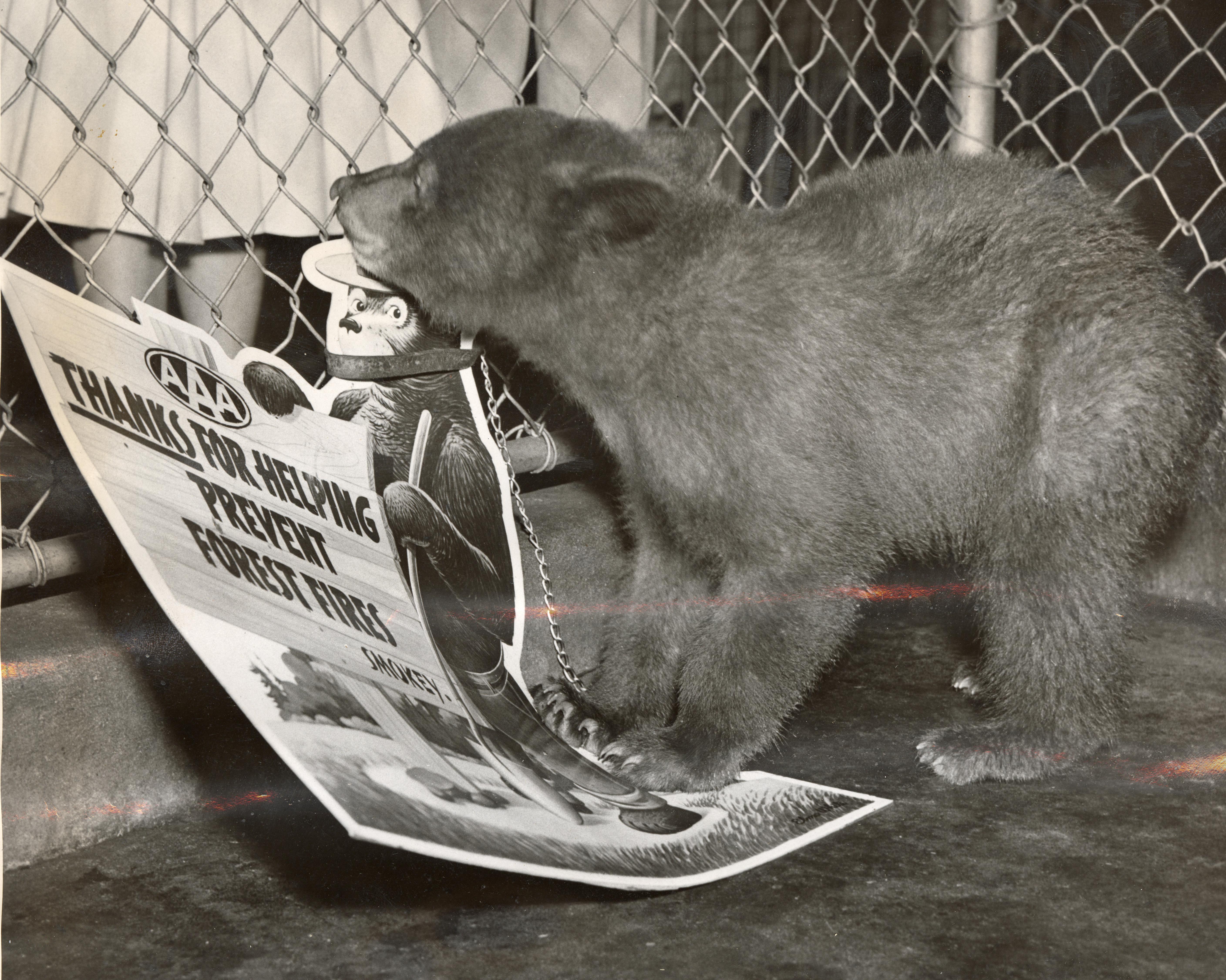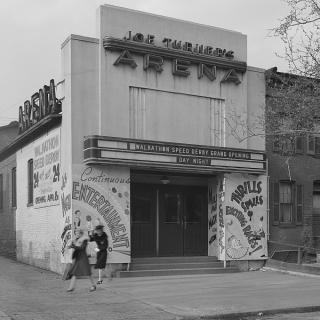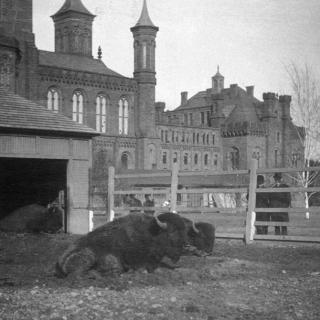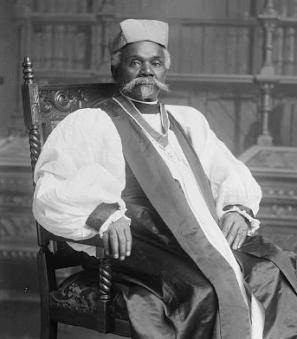How Smokey Bear Became an Icon... And a Real Life Neighbor in D.C.
:
“Only YOU can prevent forest fires.”
Many of us, especially former Boy Scouts like myself, probably associate that statement with campfire safety. Indeed, Smokey the Bear has been around for as long as most of us can remember, reminding us to follow safe fire practices in the backcountry. However, Smokey’s message – and even the bear himself – didn’t have much to do with campfires at first.
During World War II, the U.S. Government wanted to build public awareness about forest fires because of the threat presented by Japanese balloon bombs.[1] Launched from Japan, these floating bags carried incendiary devices across the ocean and U.S. officials worried that they would spark wildfires in the Pacific Northwest.
The U.S. Forest Service established the Cooperative Forest Fire Prevention (CFFP) program in 1942. With the help of the Ad Council and the Association of State Foresters, the CFFP organized a public information campaign with slogans like, “Forest Fires Aid the Enemy,” and “Our Carelessness, Their Secret Weapon.”[2] To help sell the campaign, the CFFP was looking for an animal to put on its posters.
Walt Disney allowed the government to use its popular Bambi character for a limited time. But, by 1944, the Forest Service needed a new anti-forest fire mascot and decided to create its own – a bear. The USFS authorized the character on August 9, 1944 and famed animal illustrator Albert Staehle painted the first Smokey Bear pouring a bucket of water on a campfire a couple months later.
While Staehle created the character, the man most responsible for Smokey’s growth into an icon was Arlington, Virginia artist Rudolph Wendelin, who took over as Smokey’s caretaker in the late 1940s. From his office at the Department of Agriculture in Washington, Wendelin transformed the character, which had been drawn in various ways during the first few years of the campaign. As the artist explained later,
“The idea was that [Smokey] needed to be more human to communicate his message…. The claws eventually became fingers. He could point. He could carry a shovel. He couldn’t do that with paws.”[3]
See gallery of Smokey the Bear renditions over time on the U.S. Department of Agriculture website →
By the 1950s, Smokey had his familiar hat, blue jeans, and belt buckle. He also had a deep voice, thanks to WMAL radio personality Jackson Weaver who voiced the bear for television commercials — and a catchy song.[4] Fun fact: According to Wendelin, it was because of the song that "Smokey Bear" became known by many as "Smokey the Bear" — the rhythm required an extra syllable.
The wildly successful advertising campaign made Wendelin’s character a household name across the country, but Washingtonians’ connection to Smokey was unique. That's because for us, Smokey was not only a character, he was a neighbor.
In June 1950, government officials brought a real-life “Smokey Bear,” which had been rescued from a forest fire in New Mexico to the National Zoo in Washington. The orphaned three-month-old cub had been found clinging to a charred pine tree, with third-degree burns on his paws and hide. Instantly, he became the embodiment of the fire safety public awareness effort.
As The Washington Post explained, “Smokey will be used in the U.S. Forest Service’s antifire campaign as a reminder of just what a forest fire can do. He ought to know. The one he so luckily survived started from a cigarette and destroyed 15 million board feet of timber and most of the wild life in that area. He will represent the poster bear of the same name who appears on placards in buses and vacation spots to warn tourists about forest fires.”[5]
Smokey was flown to Washington on the lap of a game warden from New Mexico. After a VIP reception at National Airport, he was welcomed to the Zoo in a ceremony for 500 kids. Stanlee Ann Miller, the 11-year-old granddaughter of New Mexico Senator Dennis Chavez, presented Smokey to 8-year-old Spicer Conant, who accepted the bear on behalf of the children of Washington.[6]
The new attraction had no trouble winning over the crowd. As the Evening Star remarked,
“It took Smokey, 10 pounds of bear cub, exactly 1 second today to become another Washington institution.”[7]
That’s partially because he was a bit of a ham.
“Smokey pulled a proffered forester’s hat right down over his ears with his paws. Then he was led around the grass while the children screamed with delight and photographers flashed scores of bulbs,” reported the Post.[8]
Over the years, Smokey’s popularity continued to grow. In the days before Panda-monium, he was one of the Zoo’s most popular exhibits and was periodically trotted out to events around town, including at least one classical music performance at Constitution Hall.[9] Fan mail poured in, and the U.S. Postal Service gave Smokey his own private D.C. zip code – 20252 – a distinction he shares with the President of the United States.
In 1962, zookeepers welcomed “Goldie,” an orphaned female bear from New Mexico who they hoped they might be able to mate with Smokey. The public followed the bears’ courtship with interest. However, dreams of Smokey or Goldie, Jr. would not materialize. There was no spark. As the Post’s Kenneth Turan remarked, “They had a pro forma marriage that even Ann Landers couldn’t have saved.”[10]
Slowed by arthritis, Smokey "retired" from federal service in 1975 and was given a membership card by the National Association of Retired Federal Employees. On November 9, 1976 he died peacefully in his sleep at the Zoo. The Post honored Smokey, who it respectfully referred to as “Mr. Bear,” in an obituary.[11]
But even as the Zoo’s most famous resident passed, Smokey the Bear’s legacy continued, handed down from one Forest Service artist to the next. As Rudy Wendelin remarked in 1995 years after he retired, “His ability to communicate and his identity with children is so important and so widespread, whoever is in charge of Smokey should take advantage of it.”[12]
Long live Smokey!
Footnotes
- ^ Kelly, John. “The Biography of Smokey Bear: The Cartoon Came First,” April 25, 2010. http://www.washingtonpost.com/wp-dyn/content/article/2010/04/24/AR2010042402441.html.
- ^ “About the Campaign | Smokey Bear.” Accessed February 13, 2018. https://smokeybear.com/en/smokeys-history/about-the-campaign.
- ^ Evans, Sandra. “Smokey Bear Caught On Like Wildfire: Icon’s Popularity Kept Artist Busy During His Decades at the U.S. Forest Service.” The Washington Post (1974-Current File); Washington, D.C. December 1, 1995.
- ^ Evans, Sandra. “Smokey Bear Caught On Like Wildfire: Icon’s Popularity Kept Artist Busy During His Decades at the U.S. Forest Service.” The Washington Post (1974-Current File); Washington, D.C. December 1, 1995.
- ^ Brinkley, Bill. “Poster Bear Smokey Joins Zoo Star List: Move Over, Gene.” The Washington Post (1923-1954); Washington, D.C. June 17, 1950.
- ^ “Smokey, Mortified by Entrancing Effect Of Forester’s Cap, Retires to Den at Zoo.” The Washington Post (1923-1954); Washington, D.C. July 1, 1950.
- ^ “Smokey the Bear Joins Zoo as 500 Laugh and Cheer.” Evening Star, June 30, 1950.
- ^ “Smokey, Mortified by Entrancing Effect Of Forester’s Cap, Retires to Den at Zoo.” The Washington Post (1923-1954); Washington, D.C. July 1, 1950.
- ^ Hume, Paul. “Fiedler Plus Smokey In a Pops Concert.” The Washington Post (1923-1954); Washington, D.C. March 16, 1954, sec. SPORTS Amusements General News FINANCIAL Classifed Advertising.
- ^ Turan, Kenneth. “Smokey's Enduring Appeal” The Washington Post, November 10, 1976. Though Smokey and Goldie never mated, apparently zoo officials deemed them capable of co-parenting and, in 1971, introduced another cub who was deemed “Young Smokey.”
- ^ Colen, B. D. “S. Bear, Fire Fighter: S. Bear, Fire Fighter.” The Washington Post (1974-Current File); Washington, D.C. November 10, 1976, sec. STYLE People/Entertainment/Leisure.
- ^ Evans, Sandra. “Smokey Bear Caught On Like Wildfire: Icon’s Popularity Kept Artist Busy During His Decades at the U.S. Forest Service.” The Washington Post (1974-Current File); Washington, D.C. December 1, 1995.





![This integrated classroom at Anacostia High School is the culmination of a seven year struggle against DC's segregated school system. [Source: LOC] Integrated classroom at Anacostia High School](/sites/default/files/styles/crop_320x320/public/AHS%20Class_0.jpg?itok=GNxSJFox)
![Sketch of the mythical fuan by Pearson Scott Foresman. [Source: Wikipedia]](/sites/default/files/styles/crop_320x320/public/2023-10/Goatman_Wikipedia_Faun_2_%28PSF%29.png?h=64a074ff&itok=C9Qh-PE1)












